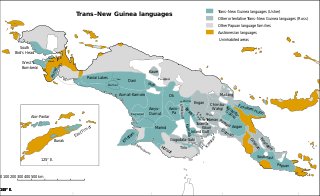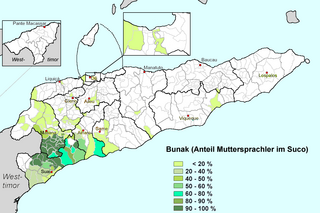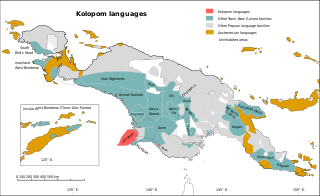
Trans–New Guinea (TNG) is an extensive family of Papuan languages spoken in New Guinea and neighboring islands, perhaps the third-largest language family in the world by number of languages. The core of the family is considered to be established, but its boundaries and overall membership are uncertain. The languages are spoken by around 3 million people. There have been three main proposals as to its internal classification.

The West Papuan languages are a proposed language family of about two dozen non-Austronesian languages of the Bird's Head Peninsula of far western New Guinea, the island of Halmahera and its vicinity, spoken by about 220,000 people in all. It is not established if they constitute a proper linguistic family or an areal network of genetically unrelated families.

The Mantion–Meax or (South)East Bird's Head languages are a language family of three languages in the "Bird's Head Peninsula" of western New Guinea, spoken by all together 20,000 people.

The Mairasi languages, also known as Etna Bay are a small independent family of Papuan languages in the classifications of Malcolm Ross and Timothy Usher, that had been part of Stephen Wurm's Trans–New Guinea proposal. They are named after Etna Bay, located in the southeastern corner of West Papua province, in Indonesia.
The Nimboran languages are a small family of Papuan languages, spoken in the Grime River watershed, that had been part of Stephen Wurm's Trans–New Guinea proposal. However, when proto-Nimboran pronouns are reconstructed (*genam "I" and kom or komot "thou"), they have little resemblance to the proto-TNG pronouns *na and *ga. Usher places them in a North Papuan stock that resembles Cowan's proposal.

The Bunak language is the language of the Bunak people of the mountainous region of central Timor, split between the political boundary between West Timor, Indonesia, particularly in Lamaknen District and East Timor. It is one of the few on Timor which is not an Austronesian language, but rather a Papuan language of the Timor-Alor-Pantar language family. The language is surrounded by Malayo-Polynesian languages, like Uab Meto and Tetum.

Western Pantar, sometimes referred to by the name of one of its dialects, Lamma, is a Papuan language spoken in the western part of Pantar island in the Alor archipelago of Indonesia. Western Pantar is spoken widely in the region by about 10,000 speakers. Although speakers often use Malay in political, religious, and educational contexts, Western Pantar remains the first language of children of the region, and is acquired to some extent by immigrants.
Bomberai Peninsula is located in the Western New Guinea region, opposite to and to the south of the Bird's Head Peninsula. To the west lies the Sebakor Bay and to the south Kamrau Bay. Sabuda island lies off the western tip of the peninsula, and is separated from the mainland by Berau and Bintuni straits.

The Kayagar languages are a small family of four closely related Trans–New Guinea languages spoken around the Cook River of Indonesian New Guinea:

The Kaure–Kosare or Nawa River languages are a small family spoken along the Nawa River in West Papua, near the northern border with Papua New Guinea. The languages are Kaure and Kosare.

The South Bird's Head or South Doberai languages are three families of Papuan languages. They form part of the Trans–New Guinea languages in the classifications of Malcolm Ross (2005) and Timothy Usher (2020), though Pawley and Hammarström (2018) do not consider them to be part of Trans–New Guinea. However, according to Dryer (2022), based on a preliminary quantitative analysis of data from the ASJP database, South Bird's Head languages are likely to be a subgroup of Trans–New Guinea.

The Alor–Pantar languages are a family of clearly related Papuan languages spoken on islands of the Alor archipelago near Timor in southern Indonesia. They may be most closely related to the Papuan languages of eastern Timor, but this is not yet clear. A more distant relationship with the Trans–New Guinea languages of the Bomberai peninsula of Western New Guinea has been proposed based on pronominal evidence, but though often cited has never been firmly established.
The Timor–Alor–Pantar (TAP) languages are a family of Papuan (non-Austronesian) languages spoken in Timor, Kisar, and the Alor archipelago in Southern Indonesia.

The Kolopom languages are a family of Trans–New Guinea languages in the classifications of Stephen Wurm (1975) and of Malcolm Ross (2005). Along with the Mombum languages, they are the languages spoken on Yos Sudarso Island.

The West Trans–New Guinea languages are a suggested linguistic linkage of Papuan languages, not well established as a group, proposed by Malcolm Ross in his 2005 classification of the Trans–New Guinea languages. Ross suspects they are an old dialect continuum, because they share numerous features that have not been traced to a single ancestor using comparative historical linguistics. The internal divisions of the languages are also unclear. William A. Foley considers the TNG identity of the Irian Highlands languages at least to be established.

The Yam languages, also known as the Morehead River languages, are a family of Papuan languages. They include many of the languages south and west of the Fly River in Papua New Guinea and Indonesian West Papua.
West Bird's Head languages are a small family of poorly documented Papuan languages spoken on the Bird's Head Peninsula of New Guinea.
The North Halmahera languages are a family of languages spoken in the northern and eastern parts of the island of Halmahera and some neighboring islands in Indonesia. The southwestern part of the island is occupied by the unrelated South Halmahera languages, which are a subgroup of Austronesian. They may be most closely related to the languages of the Bird's Head region of West Papua, but this is not well-established.
The Mbahaam–Iha languages are a pair of Papuan languages spoken on the Bomberai Peninsula of western New Guinea. The two languages, Baham (Mbaham) and Iha, are closely related to each other.
Proto-Trans–New Guinea is the reconstructed proto-language ancestral to the Trans–New Guinea languages. Reconstructions have been proposed by Malcolm Ross and Andrew Pawley.













